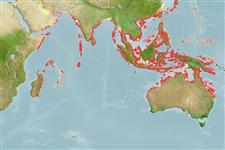Classification / Names
Common names from other countries
Main reference
Size / Weight / Age
Max length : 200 cm TL male/unsexed; (Ref. 3479); common length : 50.0 cm TL male/unsexed; (Ref. 3479); max. published weight: 145.0 kg (Ref. 4965)
Length at first maturity
Lm ?, range 29 - ? cm
Environment
Marine; freshwater; brackish; pelagic-neritic; amphidromous (Ref. 51243); depth range 0 - 23 m (Ref. 6390)
Climate / Range
Tropical, preferred 28°C (Ref. 107945); 32°N - 26°S, 47°E - 154°E (Ref. 57343)
Distribution
Indo-West Pacific: Persian Gulf to Papua New Guinea and northern Australia. Replaced by Eleutheronema rhadinum (Jordan & Evermann, 1902), in East Asia (Japan, China, Viet Nam).
Countries | FAO areas | Ecosystems | Occurrences | Introductions
Short description
Dorsal
spines
(total): 9;
Dorsal
soft rays
(total): 13-15;
Anal
spines: 3;
Anal
soft rays: 14 - 16. Pectoral filaments 4; fin membranes vivid yellow in life, except in large specimens, > ca 35 cm SL. Vomer with deciduous tooth plates on both sides, except in juveniles. Posterior part of maxilla deep, 3-4% of SL. Short tooth plate extension onto lateral surface of lower jaw. 7-9% SL (Ref. 41639).
IUCN Red List Status (Ref. 115185)
Threat to humans
Harmless
Human uses
Fisheries: highly commercial; aquaculture: commercial
Tools
Special reports
Download XML
Internet sources
Estimates of some properties based on models
Phylogenetic diversity index
PD50 = 0.6250 many relatives (e.g. carps) 0.5 - 2.0 few relatives (e.g. lungfishes)
Trophic Level
4.1 ±0.5 se; Based on diet studies.
Resilience
Medium, minimum population doubling time 1.4 - 4.4 years (Fec=680,000; assuming tm>=2)
Vulnerability
High to very high vulnerability (69 of 100)
Price category
